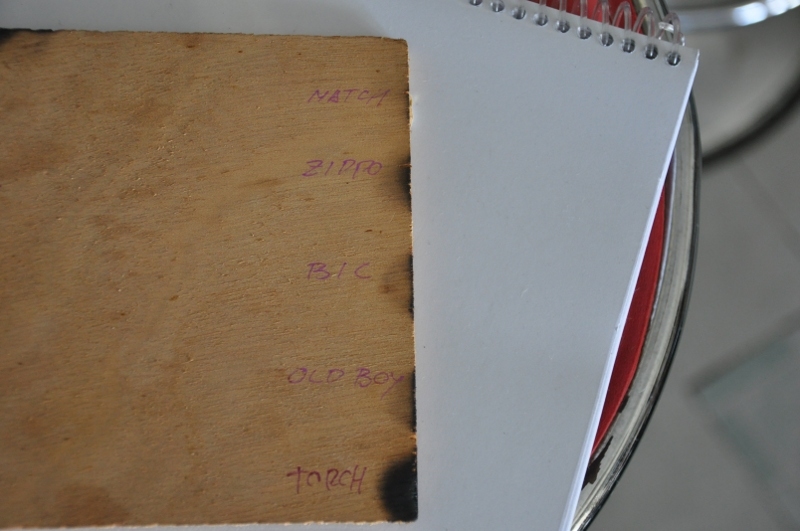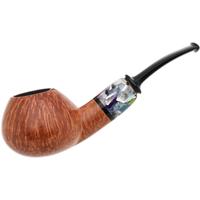The goal of the experiment is to test the damage that the different kind of flames can make to the wood on the rim of the pipe.
Damage is defined as charring and darkening of the wood.
The hypothesis is that damage will be proportional to the temperature of the flame. Theoretically, flame temperature goes (from less to more): Zippo, Match, Butane, Torch. There can be differences in temperature from oxygen and fuel exit pressure.
Expected result: I was hoping to demonstrate that zippo and match would create no noticeable damage, while a normal bic and old boy would show no difference among them, but a considerable bigger damage than the previous 2. Torch was expected to be the more damaging, but very concentrated.
Surprises in the result:
As we will see, one unexpected result of the experiment is the possibility of darkening due not to the temperature, but to the purity of the flame. "Dirty" flames stain the wood beyond cleanable possibilities (wood absorbs the stain), without damaging the integrity of the wood. Other unexpected result is the difference in the depth of the damage. Some damage is small and concentrated but runs deep in the wood, eventually damaging the material.
Description of the experiment.
Five classical lighting tools were applied to a plank of wood. The tools were (in this order)
- Match
- Zippo for pipe
- Over the Counter lighter
- Corona Old Boy
- Torch for cigar

The wood used is the cover of a cigar box. This is soft wood and will show damage faster than hard wood. I admit that it does not show the potential cleaning virtues of darkening of briar.

The experiment was conducted like this: To the static flame, the wood was applied, near to the border, for exactly 2 seconds (by chronometer).
Here is the result:

It comes as a surprise that the zippo darkens widely the wood, almost as much as the butane. Old boy concentrates the darkening in a very small area.
The torch, despite its concentrated flame, causes a wide damage.
But here is another important result:

The depth of the burning. Less easy to see, it is concluded that match and zippo barely burn the wood at all. The butane lighter does an small but irrefutable burning. Old Boy on the other hand concentrates a higher temperature in a smaller area, getting to burn the wood deeply.
Conclussions:
Matches are, by far, the less damaging to the wood in terms of darkening and burning.
Zippos are safe to not burn and damage the wood, but their flame is very darkening due to impurities.
Bic and over the counter butane lighters provide small burning and darkening, but in a broad area.
Old boy comes as a surprise. Its "angle" comes from higher fuel pressure which increases the temperature causing narrow but deep damage.
Torch is very destructive to the wood in width and depth.
Repeated experiment as control:

Final word: The experiment is conclusive about the damages of the flames to the wood, but does not take into account the actual practice of the smoker, such as time employed to light with different lighters, and the ability of pinpoint the flame to the tobacco. Considering that, results in a pipe can change from person to person.
I encourage the experiment to be replicated to test, broaden or rectify its conclusions
Carlos.
Damage is defined as charring and darkening of the wood.
The hypothesis is that damage will be proportional to the temperature of the flame. Theoretically, flame temperature goes (from less to more): Zippo, Match, Butane, Torch. There can be differences in temperature from oxygen and fuel exit pressure.
Expected result: I was hoping to demonstrate that zippo and match would create no noticeable damage, while a normal bic and old boy would show no difference among them, but a considerable bigger damage than the previous 2. Torch was expected to be the more damaging, but very concentrated.
Surprises in the result:
As we will see, one unexpected result of the experiment is the possibility of darkening due not to the temperature, but to the purity of the flame. "Dirty" flames stain the wood beyond cleanable possibilities (wood absorbs the stain), without damaging the integrity of the wood. Other unexpected result is the difference in the depth of the damage. Some damage is small and concentrated but runs deep in the wood, eventually damaging the material.
Description of the experiment.
Five classical lighting tools were applied to a plank of wood. The tools were (in this order)
- Match
- Zippo for pipe
- Over the Counter lighter
- Corona Old Boy
- Torch for cigar

The wood used is the cover of a cigar box. This is soft wood and will show damage faster than hard wood. I admit that it does not show the potential cleaning virtues of darkening of briar.

The experiment was conducted like this: To the static flame, the wood was applied, near to the border, for exactly 2 seconds (by chronometer).
Here is the result:

It comes as a surprise that the zippo darkens widely the wood, almost as much as the butane. Old boy concentrates the darkening in a very small area.
The torch, despite its concentrated flame, causes a wide damage.
But here is another important result:

The depth of the burning. Less easy to see, it is concluded that match and zippo barely burn the wood at all. The butane lighter does an small but irrefutable burning. Old Boy on the other hand concentrates a higher temperature in a smaller area, getting to burn the wood deeply.
Conclussions:
Matches are, by far, the less damaging to the wood in terms of darkening and burning.
Zippos are safe to not burn and damage the wood, but their flame is very darkening due to impurities.
Bic and over the counter butane lighters provide small burning and darkening, but in a broad area.
Old boy comes as a surprise. Its "angle" comes from higher fuel pressure which increases the temperature causing narrow but deep damage.
Torch is very destructive to the wood in width and depth.
Repeated experiment as control:

Final word: The experiment is conclusive about the damages of the flames to the wood, but does not take into account the actual practice of the smoker, such as time employed to light with different lighters, and the ability of pinpoint the flame to the tobacco. Considering that, results in a pipe can change from person to person.
I encourage the experiment to be replicated to test, broaden or rectify its conclusions
Carlos.











